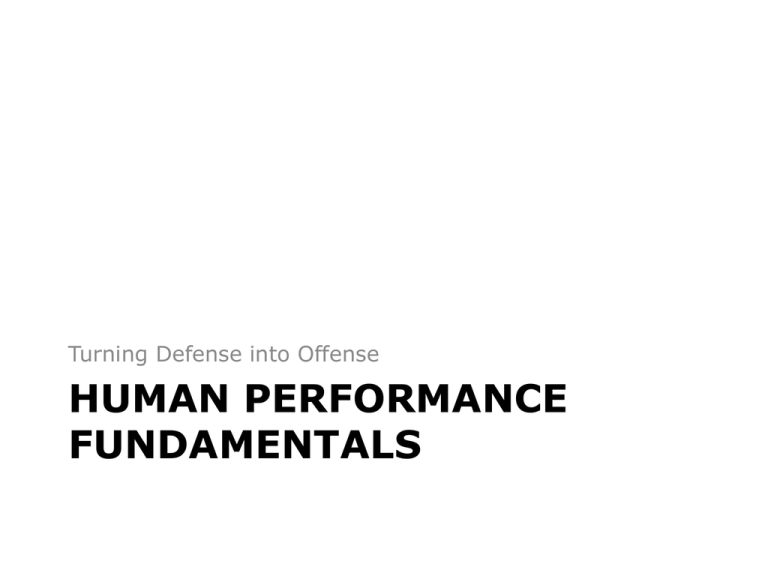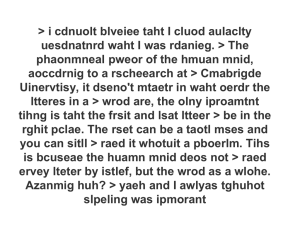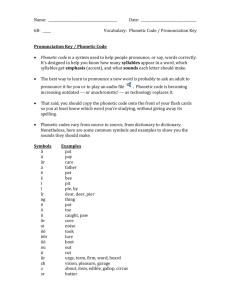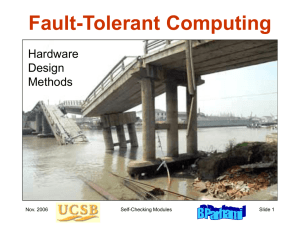HP101 Fundamentals Presentation
advertisement

Turning Defense into Offense HUMAN PERFORMANCE FUNDAMENTALS Introductions • • • • • Name Position Location Time on job Expectations 2 Housekeeping • • • • • • Restrooms Exits (fire assembly area) Breaks Cell Phones Parking Lot Safety Note 3 Purpose of this Training To reduce the frequency and severity of events and improve operational performance. Senior Management Quote Here 4 At (your company name here), we value safety • HP Tools and Concepts • Error free = event free • Event-Free Clocks • Goal is ZERO accidents 5 Why Learn this at (your company name here)? • Values: what we care about most; our beliefs. • Culture: all the common values of the company. These influence everyone’s attitudes, choices, and behavior. • Performance Improvement: we can anticipate an error-free workplace 6 Training Objectives • Describe the types and causes of human error • Describe human performance concepts and principles • Apply the principles of human performance in a case study • Identify the human performance tools • Apply the appropriate tools in work situations 7 Module 1 Types and Causes of Human Error 8 Defining Human Performance • • • • Department of Energy (DOE) Concepts Principles System – Not step-by step process • Behaviors 9 Little Things Lead to Big Things! 1 10 30 600 10 Layers of Responsibility Contributing to Human Performance Leaders Organization Individuals Human Performance 11 The Elements that Impact Human Performance It is a system of interdependencies 12 Counting Exercise Read the following sentence and count the number of F’s you find. 13 Counting Exercise FINISHED FILES ARE THE RESULT OF YEARS OF SCIENTIFIC STUDY COMBINED WITH THE EXPERIENCE OF YEARS. 14 Counting Exercise FINISHED FILES ARE THE RESULT OF YEARS OF SCIENTIFIC STUDY COMBINED WITH THE EXPERIENCE OF YEARS. Did you find six? 15 Reading Exercise Clearly read the following paragraphs. 16 Reading Exercise Aoccdrnig to rscheearch at Cmabrigde Uinervtisy, it deosn't mttaer in waht oredr the ltteers in a wrod are wirttn, the olny iprmoetnt tihng is that the frist and lsat ltteer be at the rghit pclae. The rset can be a total mses and you can sitll raed it wouthit porbelms. Tihs is bcuseae the huamn mnid deos not raed ervey lteter by istlef, but the wrod as a wlohe. Amzanig huh? 17 Types of Errors: • Active Error – An obvious mistake that has immediate, visible consequences. • Latent Error – A hidden mistake that has consequences that are not immediate. * (Seat belts are a good idea) 18 How we commit errors Slip Attention Failure Intrusion, Intrusion,Omission, Omission, Misorder, Mistiming Mis-order, Mistiming Lapse Memory Memory Failure Failure Forgetting Forgetting intention intention Lost Lost place place Omitting Omitting planned planned item item Unintended Unintended Action Action Human Error Mistake Planning Failure Misapplication of good rule Application of bad rule Intended Action Violation Shortcuts 19 Human Information Processing Shared Attention Resources Sensing Thinking Acting Source: Wickens, 1992 Information Flow Path 20 Performance Modes High 1 in 10 1 in 100 Source: James Reason. Managing the Risks of Organizational Accidents, 1998. Attention (to task) Inaccurate Mental Picture Error Rate Reduction 1 in 1,000 Misinterpretation Inattention Low Low Familiarity (w/ task) High 21 Error Traps produce an error-likely situation 22 Sometimes we’re up and sometimes we’re down! Recognize and work with it. 23 Event Causation 24 Module 2 Human Performance Concepts and Principles 25 Five Principles of Human Performance 1. People are fallible. 2. Error situations are predictable. 3. Organization influences behavior. 4. Reinforcement effects performance. 5. Understanding the past helps avoid events. 26 Layers of Responsibility Contributing to Human Performance Leaders Organization Individuals Human Performance 27 Behavior vs. Result 1 2 3 4 1 1 2 2 3 3 4 4 5 4 3 2 1 1 2 3 4 5 4 4 3 3 2 2 1 1 4 3 2 1 Which shooter had better “results”? 28 Performance Formula Behavior: the way you do your job Results: getting your job done Performance: everyone succeeding together 29 Functions of Defenses • • • • • • Create Awareness Detect and Warn Protect Recover Contain Enable Escape 30 Defense in Depth 31 Sources of Latent Organizational Weakness Processes • • • • • • Control of work Training Accountability policy Equipment design Process development Use of work force Values • • • • • Priorities Measures & controls Coaching & teamwork Rewards & sanctions Reinforcement 32 Module 3 Applying the Principles 33 Develop Case Study/Video for your Organization 34 Questions on the Case Study 1. What were the consequences of this event, short and long range, and what was their significance? 2. What were some of the latent organizational weaknesses? 3. What defenses were removed or flawed? 4. What values or organizational beliefs may have contributed to the event? 5. What were some of the error traps? 6. What can we learn from this case study? 35 Module 4 Human Performance Tools 36 Error-Prevention Tools 1. Self-checking - S.T.A.R. 2. Peer-checking - Team S.T.A.R. 3. Three-Way Communication 4. Pre-Job Briefing (FKA Tailboard) 5. STOP if Unsure 6. 2-Minute Drill 37 Error-Prevention Tools (continued) 7. Questioning Attitude 8. Turnover 9. Place Keeping 10. Flagging 11. Phonetic Alphabet 12. Conservative Decision Making 38 Error-Prevention Tools (continued) 13. Procedure Use and Adherence 14. Concurrent Verification 15. Post-job Review Management Tools include: 1. Observations 2. Self-Assessments 3. Operating Experience 39 Self-Checking - S.T.A.R • STOP – Is my attention focused on the task? • THINK – What action am I about to perform? • ACT – Am I performing correctly? • REVIEW – Did I get the expected results? * 40 Peer-Checking Team S.T.A.R • Use a second set of eyes to detect and correct. • Both individuals actively participate in task performance. • Use this tool prior to the performance of critical tasks. 41 Sometimes we just blow it! 42 3-Way Communication • Helps you verify that the correct information is transferred. • Used during the execution of critical steps to formalize the communication. • Repeat-back is required when obtaining a clearance or a switching order. • Regulatory requirement in certain situations Critical transactions (i.e. communicating to control personnel) 43 3- Way Communication What Dennis said (as he was leaving the room): “Don, turn off the foam machine” What Don heard: “Don’t turn off the foam machine.” 44 The Result 45 Pre-Job Briefing • What is the task to be accomplished? • Who’s doing what? • How will we communicate? • What safety equipment do I need? • What is the worst thing that could happen and how am I going to prevent it? 46 STOP if Unsure • If you have a feeling something is not right – Stop! • If you are not positive of the course of action or the outcome of your actions – Stop! 47 Two-Minute Drill • Initial worksite assessment. • Use after a break or distraction. • Helps to reset and verify work conditions. • Provides a chance to assess changing workplace hazards at the workplace. 48 Questioning Attitude • • • • • Challenges assumptions Stimulates a healthy skepticism Vigilance when things don’t seem right Being open to challenges by others Use when uncertain, confused, doubtful 49 Turnover • Information/awareness continuity • Accurate transfers • Transferring responsibilities • Over communicate – Don’t assume • Record information – Ensure accuracy • Ask clarifying questions 50 Place Keeping • • • • Prevents step duplication or omission Records step completed and yet to be performed Use during Switching and Clearance procedures Circle & Slash the step number, sign or initial a blank or, check a box 51 Flagging • Correct equipment identification • Alerts others that equipment is unavailable • Shields components from inadvertent use • Used on similar–looking equipment • Mandates use of peer and self-checking • Remains in place until work is complete 52 Phonetic Alphabet • Provides understandable difference between letters • Use when letters might sound alike • Use in high noise areas • Use at times of poor radio/telephone reception 53 Standard Phonetic Alphabet 54 Conservative Decision Making • • • • • • Deliberate and methodical Clarifies goals and options Planning Resources and expertise Minimize uncertainty Facts only – challenge assumptions 55 Procedure Use & Adherence • Understand a procedure’s intent and purpose and follow its direction. • Perform all actions as written. • Stop if procedure cannot be used as written. • Procedure may be corrected before continuing. • Expectation: Frequent document use instead of memory and recall. 56 Concurrent Verification • Separate confirmation by two individuals • Error prevention on equipment status/condition changes • Independent conclusions by all parties • Verifier takes no cues from performer • Not Peer Checking 57 Post-job Review • Identifies what went well • Identifies potential improvements • Allows feedback from active participants • Identifies actual versus planned outcome • Determines future changes in similar tasks • Reviews lessons learned 58 Module 5 Apply the Tools 59 How valuable is good communication? 60 61 Objective Review • Describe the types and causes of human error • Describe human performance concepts and principles • Apply the principles of human performance in a case study • Identify the human performance tools • Apply the appropriate tools in work situations 62 The Big Question • Questioning Attitude “What’s the worst that could happen and how am I going to prevent it?” 63 Your turn Questions? 64 Thank You 65 Knowledge Check • Complete the knowledge check on your own. • XX% minimum is required. • You may use your notes. • Time limit: XX minutes. 66









